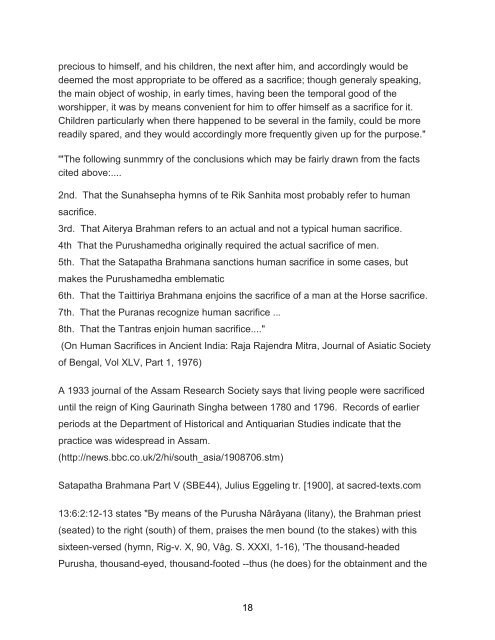KathaUpanishad
You also want an ePaper? Increase the reach of your titles
YUMPU automatically turns print PDFs into web optimized ePapers that Google loves.
precious to himself, and his children, the next after him, and accordingly would be<br />
deemed the most appropriate to be offered as a sacrifice; though generaly speaking,<br />
the main object of woship, in early times, having been the temporal good of the<br />
worshipper, it was by means convenient for him to offer himself as a sacrifice for it.<br />
Children particularly when there happened to be several in the family, could be more<br />
readily spared, and they would accordingly more frequently given up for the purpose."<br />
'"The following sunmmry of the conclusions which may be fairly drawn from the facts<br />
cited above:....<br />
2nd. That the Sunahsepha hymns of te Rik Sanhita most probably refer to human<br />
sacrifice.<br />
3rd. That Aiterya Brahman refers to an actual and not a typical human sacrifice.<br />
4th That the Purushamedha originally required the actual sacrifice of men.<br />
5th. That the Satapatha Brahmana sanctions human sacrifice in some cases, but<br />
makes the Purushamedha emblematic<br />
6th. That the Taittiriya Brahmana enjoins the sacrifice of a man at the Horse sacrifice.<br />
7th. That the Puranas recognize human sacrifice ...<br />
8th. That the Tantras enjoin human sacrifice...."<br />
(On Human Sacrifices in Ancient India: Raja Rajendra Mitra, Journal of Asiatic Society<br />
of Bengal, Vol XLV, Part 1, 1976)<br />
A 1933 journal of the Assam Research Society says that living people were sacrificed<br />
until the reign of King Gaurinath Singha between 1780 and 1796. Records of earlier<br />
periods at the Department of Historical and Antiquarian Studies indicate that the<br />
practice was widespread in Assam.<br />
(http://news.bbc.co.uk/2/hi/south_asia/1908706.stm)<br />
Satapatha Brahmana Part V (SBE44), Julius Eggeling tr. [1900], at sacred-texts.com<br />
13:6:2:12-13 states "By means of the Purusha Nârâyana (litany), the Brahman priest<br />
(seated) to the right (south) of them, praises the men bound (to the stakes) with this<br />
sixteen-versed (hymn, Rig-v. X, 90, Vâg. S. XXXI, 1-16), 'The thousand-headed<br />
Purusha, thousand-eyed, thousand-footed --thus (he does) for the obtainment and the<br />
18


















